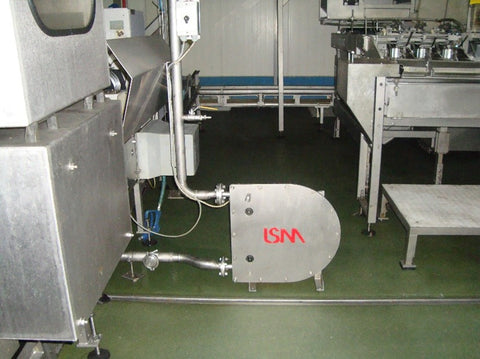Industries & Applications
What Pumps Do Abattoirs Use?
Abattoirs, also known as slaughterhouses, are facilities that process and handle animal meat for consumption.
Welfare, hygiene and efficiency, are the key to successful operations and the consistency that automation brings plays a large part in this. One important component in the abattoir process is the use of peristaltic pumps to move fluids and viscous materials through the processing line.
Here, we explore how LSM peristaltic pumps are often used in abattoir applications.

What are Peristaltic Pumps and Why are they Good for Abattoir Use?
Peristaltic pumps are a type of positive displacement pump that works by squeezing and releasing a flexible tube, creating a vacuum that draws in fluid and then forces it out through the tube.
LSM peristaltic pumps are particularly well-suited for abattoir applications because of their ability to handle a wide range of viscous materials including blood, fat and other by-products of the meat processing industry. They are also good for shear-sensitive food products that might be damaged by other pumps such as fish and meat. In fact, LSM pumps are used in some fish docks to transfer fish from boat to shore without damage.
One of the key benefits of using LSM peristaltic pumps in abattoir applications is their ability to maintain consistent flow rates and pressure, which is important for maintaining product quality and minimising waste. These pumps can be easily adjusted to accommodate different materials and processing speeds, ensuring that the meat processing line operates smoothly and efficiently.
Bone can cause problems for some pumps by causing blockages or damage to expensive component parts. An important advantage of using LSM peristaltic pumps in abattoirs is their ability to handle abrasive materials and larger solids without causing damage to the pump itself.
The flexible tubing used in these pumps is designed to resist wear and tear, even when exposed to abrasive bone fragments and other solids that are often found in abattoir processing lines. Should a blockage occur, these pumps can be run in reverse rotation to aid unblocking and the pipe is easy and inexpensive to replace.
Increasingly so, abattoir waste is being recycled into energy and fertiliser through anaerobic digestion (AD) plants. These AD facilities use LSM pumps to move the digestate through at the required rate, being able to handle watery liquids, bone and feather containing pastes, through to thickened sludge which becomes a healthy soil improver.
As the hosing pipe is the only part of the peristaltic pump that comes into contact with the pumped material, LSM pumps are preferred for their hygienic features too. The pipes are easy to clean and swap over, removing contamination risks and promoting cleanliness.
So, whether it’s transferring abattoir waste and animal by-products to an AD or other recycling plant, or transferring quality meat products such as poultry, fish and lard to packaging lines, LSM pumps are very common in abattoirs.

How do Peristaltic Pumps Compare to Progressive Cavity Pumps?
Progressive cavity pumps are, like peristaltic, known for their consistent flow rate and paste handling ability. However, they relies on maintaining the precise gap between the stator and rotor screw to perform, making them vulnerable to premature wear and expensive repair and downtime costs.
Peristaltic pumps are generally more tolerant of solids than rotary screw pumps, with parts quicker and are more cost-effective to change. As the hose is the only part that makes contact with the abattoir materials and is quick and easy to change, the same pump unit can be used for different process streams without causing cross-contamination. Progressive cavity pumps might work well in certain abattoir processes that only involve smooth, non-abrasive paste.

What Other Pumps are Used in Abattoirs?
In addition to peristaltic pumps and progressive screw pumps, centrifugal slurry pumps are still sometimes best for certain abattoir applications.
A heavy-duty centrifugal pump like the SlurryPro can pump larger volumes for solids-laden, thick slurry over distance at speed, whilst still providing the necessary wear and tear resistance. This makes the SlurryPro good for handling abattoir sludge waste and by-products, whilst peristaltic pumps are better for transferring shear-sensitive or food-grade product at a controlled feed rate.
In addition to their durability and reliability, LSM peristaltic pumps are also easy to maintain and clean. The pump head and tubing can be quickly and easily removed for cleaning and inspection, reducing downtime and ensuring that the pump operates at optimal efficiency.
LSM pumps have no need for seals and the design means back-flow is prevented when the pump stops for any reason, so the risk of leakage or lubricant contamination is vastly reduced.
Choose the Best Pump for Each Abattoir Process
When selecting a peristaltic pump for abattoir applications, it's important to choose the best-suited type and model that is designed specifically for the demands of meat processing.
Pump performance, energy use and servicing costs are likely to far outweigh the purchase price. LSM peristaltic pumps and SlurryPro centrifugal are available in a range of sizes and configurations, making it easy to find a model that meets your specific requirements.
LSM peristaltic pumps are an excellent choice for abattoir applications due to their ability to handle a wide range of viscous materials, maintain consistent flow rates and pressure, resist wear and tear from abrasive and corrosive materials, and be easily maintained and cleaned.
When selecting a pump for your abattoir, be sure to consider the efficiency and life-time cost. Atlantic Pumps can advise on the LSM or SlurryPro model that is designed for the unique demands of your meat processing facility.
